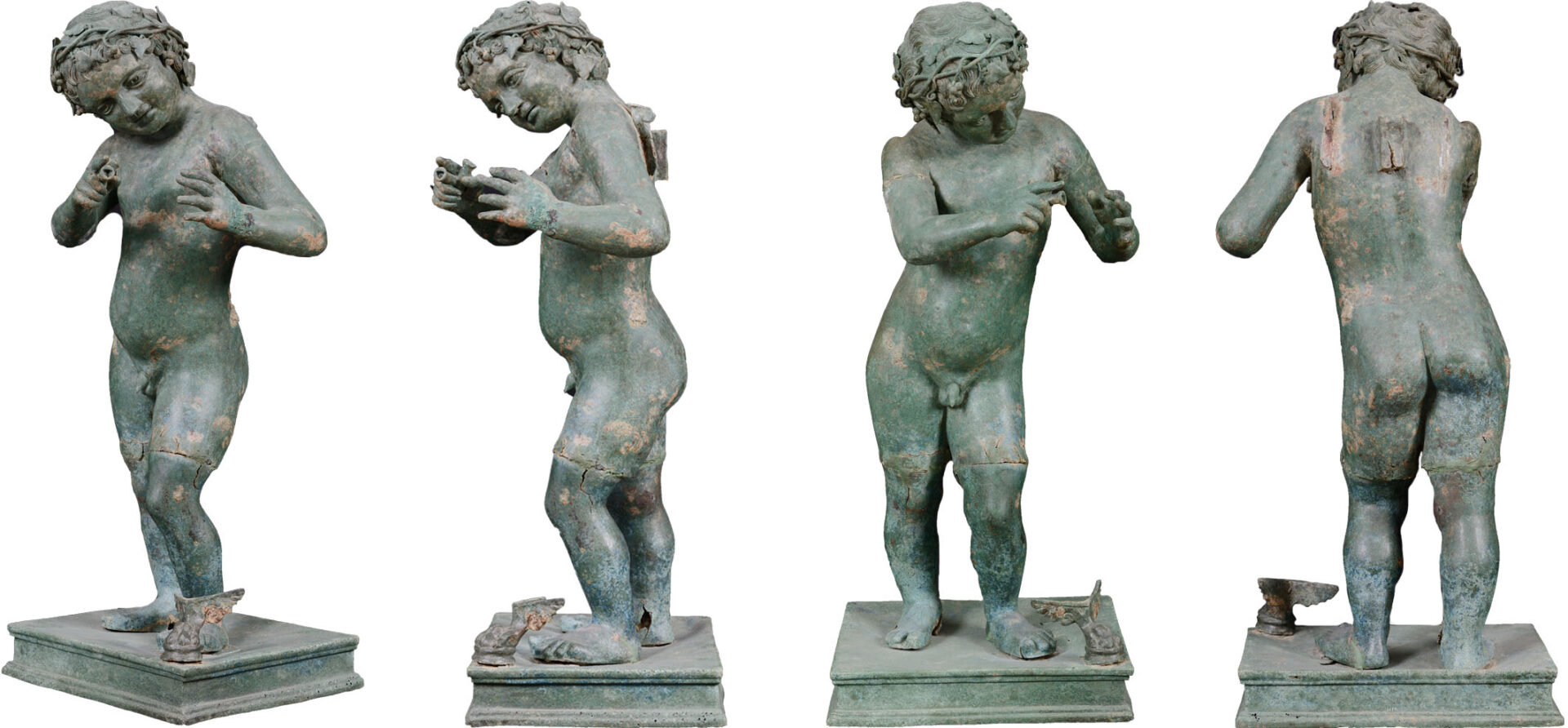Exhibit of the month
Aphrodite’s child
Bronze Eros statuette
Metalwork Collection, inv. no. X 16771
Provenance: Ambelokipoi area, Athens
Dimensions: Total height 74 cm
Date: 1st c. AD.
Display location: Room 38, Showcase 51 (no. 12)
The statuette depicts Eros naked as a chubby infant. The figure rests on the right leg, while the loose left one projects slightly. The sigmoid bent torso is frontal rendered while the head turns sharply to the left. His arms, bent at the elbows, extend in front of the chest. He holds a plectrum or musical clef in the right hand, while the slightly bent fingers of his left hand would hold an object, possibly a kithara or lyre, towards which he directs his gaze. The large head bears a double ivy wreath with fruits hanging like bunches. Short, spiral and curved locks of hair frame the round face, where dominate the huge almond-shaped eyes, with inset pupils, and the half-open fleshy lips. The fleshy cheeks emphasize the child-looking of the figure, as does the rendering of the naked body, especially the chubby short legs and the swollen belly. A small part of the left wing remains on the back, while the right wing, attached in antiquity to the scapula with tin, is lost. Eros stands on a rectangular parallelepiped base decorated above and below with relief bands. In its front right corner, is preserved part of a support in the form of a lion’s foot with an angular upper end, decorated on the outside with relief half-anthemia. The head, the torso and the limbs at their greater part were casted separately, while the joints of the parts are strikingly visible. Between its wings, there is a hollow socket, from which a stem would emerge, possibly for receiving a lamp, allowing the interpretation of the statuette as a candelabrum (lamp stand), perhaps in reuse.
It belongs to the so-called “Ambelokipoi Hoard”, i.e. the set of 17 bronze statuettes of various sizes and types, which were discovered in 1964 during excavation works carried out by the Athens Water Company in the Athenian neighborhood of Ambelokipoi, near the modern Panathinaikos football stadium. They are miniature copies or reworkings of well-known Classical and, chiefly, Hellenistic statues, considered as works of Attic workshops that were active from the 1st century. BC until the 1st and 2nd c. AD[1]. The works could had been concealed by their owners under the threat of a raid launched by a barbarian tribe, such as the Heruli (267 AD) or the Goths led by Alaric I (late 4th c. AD). According to a different conjecture a mining workshop operated at the site and the statues were going to be reused as raw material.
Eros was the primordial generative cause of everything, the most powerful force of attraction that governs gods and humans. In post-Homeric mythology various candidates were presented as begetters of Eros, however, according to the prevailing myth he is the son of Aphrodite and Ares[2]. He was worshiped as the god of lust, love, sexual intercourse and fertility. Eros is mentioned by Hesiod (Theogony, 120) as the most beautiful among the immortals, but the main characteristic of the god was its youth. At first, Eros was conceived as a pubert, while around 300 BC the poetry of the Hellenistic period defines him with adjectives that refer to early age stages, meaning toddler or infant. Gradually, artists depict Eros mainly at this early age. Impressive are the playful figures of the Lilliputian Erotes with their restless child-like bodies represented in tender scenes with their mother, quarrelling with other Erotes or being punished for naughty behavior. Deviating from the activities of their mortal peers, however, we see them participating in komos scenes after banquets as a happy Dionysiac company, or becoming angels of death holding an upside down torch. They are often attributed with symbols of fertility, fun and eroticism, such as flowers, musical instruments, birds.
The winged infant Eros from the Ampelokipi Hoard crowned with a Dionysian wreath of ivy leaves and with the status of a musician becomes a symbol of the joy of life, luxury and love, absolutely suitable for the decoration of a banquet hall of a Roman villa.
[1] The “Ambelokipoi Hoard” is exhibited as a unit in Room 38 of the Metalwork Collection (Showcases 50-52).
[2] From the 7th c.BC onwards in the world of poets and artists the myth that connects Eros with Aphrodite prevails. Mainly the lyric poet Sappho creates the myth of the birth of the sweet-bitter Eros from the goddess of beauty as the fruit of her illicit love affair with Ares, having a twin brother, Imeros, synonymous with sweet desire.
Alexandra Chatzipanagiotou
Bibliography:
Π. Κρυστάλλη-Βότση, Τα Χαλκά των Αμπελοκήπων, Αθήνα 2014, 24-27, pl. 3-4.
P. Krystalli – Votsi, “Αteliers toreutiques attiques à l’ époque romaine”, Acta of the 12th International Congress on Ancient Bronzes: Nijmegen 1992, Nijmegen 1995, 271-281.
Μ. Lagogianni – Georgakarakou (ed.), Odysseys. Catalogue of an Exhibition, National Archaeological Museum, 03.10.2016 – 03.10.2017, Athens 2016, 457, cat.no. 296 (Κ. Bairami).
H.F. Sharpe, From Hieron and Oikos: the religious and secular use of Hellenistic and Greek Imperial bronze statuettes, Indiana 2006, 119-128, 209, no. 35.
Φ. Σταυρόπουλος, Αθήναι-Αττική, Οδός Παναγή Κυριακού (Αμπελόκηποι), ΑΔ 20 (1965), Χρονικά Β 1, 103, no. 46-1, pl. 58α-β.
Selected bibliography about Eros:
LIMC III (1986), s.v. Eros, 850-942 (A. Hermary, H. Kassimatis, R. Vollkommer).
N. Chr. Stampolidis – Y. Tassoulas, Eros. From Hesiod’s Theogony to Late Antiquity, Catalogue of an Exhibition, Museum of Cycladic Art, Athens 2009.
See also the presentation The alluring Love in the online unit “Exhibit of the Month” at the official site of the National Archaeological Museum: https://www.namuseum.gr/en/monthly_artefact/?pick_month_year=2018


